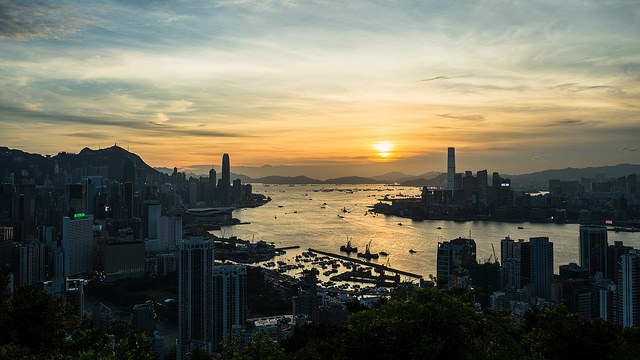
Victoria Harbour at sunset. Photo © Pasu Au Yeung, licensed Creative Commons Attribution.
While Victoria Harbour might have been the waterway that helped float the city’s fortunes, this once grand port has been on the receiving end of some equally grand downsizing, reducing it from endless ocean to roaring river and some say a future as a trickling tap. The culprit? Ever since the 1850s the Hong Kong government has been dumping earth into the harbor to create more premium-priced flat land to build on. Incredibly, the harbor is already half the size it once was and it’s not only here that the government has been making Hong Kong bigger. Over the years, roughly 70 square kilometers of land throughout the whole territory were reclaimed (just shy of the 76 square kilometers of Hong Kong Island’s total size) and they include flagship projects such as Hong Kong Disneyland and Hong Kong Airport, which were both built on land reclaimed from the sea. With land prices responsible for much of the Hong Kong government’s pocket money and some of the most densely populated neighborhoods on the planet, it’s not surprising that the government continues to reclaim land.The reason for this land fabrication project is lack of space. When the British army first splashed ashore onto Hong Kong Island in the 1840s, they would have found room to plant their flag, park their suitcases, and little else. Victoria Peak sloped into the sand around a kilometer from the shoreline, leaving just a sliver of land for development. At the time, the seafront on Hong Kong Island would have run just in front of Queen’s Road Central, where many of the first warehouses and piers were built. The addition of equally inhospitable Kowloon and the New Territories to her Majesty’s real-estate portfolio provided little extra flat land and as an increasing number of traders and merchants arrived and the demand for space became more pressing, they decided to start giving the hills a haircut and dumping the earth into the water. It’s a program of land reclamation that has continued in fits and starts to this very day.You’ll find indicators to the shifting shoreline throughout the city. Look for Tin Hau temples, such as the one on Queen’s Road East in Wan Chai, that pay homage to the goddess of the sea. These once stood within spitting distance of the sea, but some now find themselves marooned behind 10 blocks of city concrete or more. The same has happened to some of the city’s most prestigious buildings, such as the Mandarin Oriental, which were once perched on the seafront but now have to peek through blocks of skyscrapers to get a sea view. With land prices responsible for much of the Hong Kong government’s pocket money and some of the most densely populated neighborhoods on the planet, it’s not surprising that the government continues to reclaim land. While the projects usually throw up little controversy, protestors have become increasingly vocal in their demands for the quickly disappearing Victoria Harbour to be spared any more slimming. Come back in a few years and you might just be able to walk from Central to Tsim Sha Tsui.
Excerpted from the First Edition of Moon Living Abroad in Hong Kong.